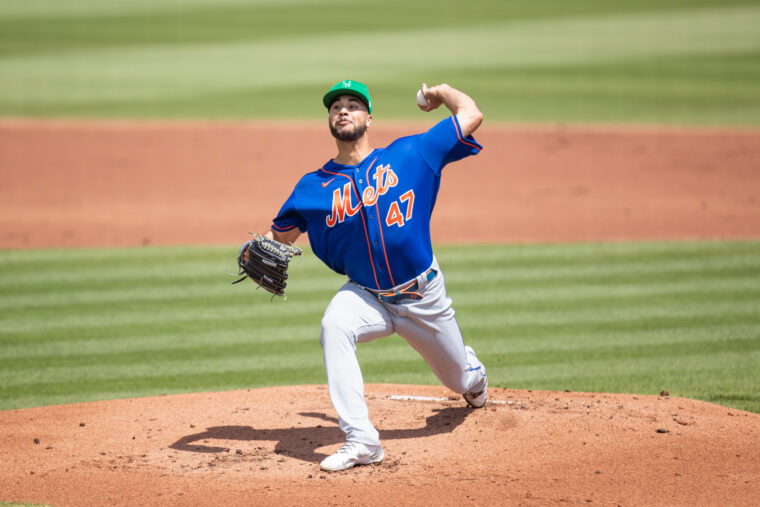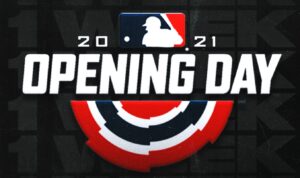
Credit: Mary Holt-USA TODAY Sports
After experiencing a lack of pitching depth throughout last season, the New York Mets were on a mission to strengthen their starting rotation over the offseason and it seems those efforts are starting to pay off as Opening Day nears.
In an effort to acquire a reliable front of the rotation starter, the front office received pitcher Carlos Carrasco in the Francisco Lindor trade with the Cleveland Indians over the winter, setting him up to be the No. 2 hurler behind ace Jacob deGrom. Unfortunately, the 34-year-old recently suffered a hamstring tear and is expected to be sidelined for at least six-to-eight weeks, likely delaying his Mets debut until June.
With Carrasco unavailable for the start of the season, his absence will leave a considerable hole in the club’s pitching staff and it’s one that certainly won’t be easy to fill. But since president Sandy Alderson and his staff brought in multiple starters over the offseason, this new group of promising arms should help them tread water until the summer rolls around, which is when both Carrasco and Noah Syndergaard could return from their respective injuries.
Until then, the onus will be on pitchers like Taijuan Walker, David Peterson and Joey Lucchesi – who was acquired from the San Diego Padres as part of a three-team trade for Joe Musgrove – to help carry the load over the first few months of the 2021 campaign. In particular, this unfortunate injury to Carrasco has opened up an opportunity for Lucchesi to earn a spot in the rotation and that’s something he probably wasn’t expecting to receive at the time of his trade, as most experts considered him as a multi-inning reliever.
Thanks to his encouraging performance this spring, where he’s allowed just four hits, three earned runs, three walks and has struck out 11 batters through 8 1/3 innings, it appears the 27-year-old is currently the front-runner for the final rotation spot. Having said that, the former Padre’s work is far from complete as he attempts to improve off the worst statistical performance of his career, which forced him to spend the majority of last season at the alternate training site.
Once Lucchesi arrived for the second version of spring training, he competed for a spot in San Diego’s rotation and ultimately had his tryout as a starter stretch into the shortened season, although things went sideways fairly quickly for the 6′ 5″ hurler. Failing to perform effectively in his first two starts, the towering pitcher became expendable at that point and was only utilized during a doubleheader through the remainder of his third campaign in the majors.

Credit: Jasen Vinlove-USA TODAY Sports
Over his three appearances in 2020, the left-hander compiled just 5 2/3 innings, producing a miserable 7.94 ERA, 6.24 xERA, 183 ERA- 3.01 FIP, 5.06 xFIP, 2.65 WHIP, .448 AVG, .542 BABIP, 15.6% strikeout rate, 6.3% walk rate, 37.5% LD rate, 37.5% GB rate, 25.0% FB rate and a 0.2 fWAR rating.
Digging deeper into Lucchesi’s struggles, he allowed a .360 xAVG, .433 xSLG, .447 wOBA, .373 xwOBA, .409 xwOBAcon and only threw 53.1% of his pitches for first-pitch strikes. With this in mind, it’s clear the former fourth-round pick must get ahead in counts more often and will need to dramatically reduce the amount of contact he allows moving forward.
While the Southeast Missouri State product only features three pitches, he relies heavily on his low-90s sinker, utilizing it 49.6% of the time in 2020, and leans on it to induce a considerable amount of ground balls. Even though it generated a career-high 63.9% GB rate last season, his inconsistent command allowed hitters to create plenty of damage against his primary offering, resulting in a .308 AVG, .296 xAVG, .462 SLG, .393 xSLG, .398 wOBA and a .377 xwOBA.
Here’s where Lucchesi located his sinker in 2020:

Source: BaseballSavant.com
If Lucchesi hopes to take a positive step forward in 2021, it’ll be crucial for him to improve the command of his sinker, particularly in the early stages of at-bats. Even though it probably won’t be easy to accomplish this feat, especially since his sinking fastball only averaged 23.2 inches of drop last season, doing so would likely help him increase his strike percentage and also set up his other weapons more effectively as well.
Similar to his sinker, the soft-throwing lefty failed to perform effectively with his low-90s cutter, which finished tied for the second-best average inches of drop (18.0) and it also generated the fourth-most added drop (5.9) among all qualified pitchers in 2019, according to BaseballSavant.com. Despite this impressive vertical movement, his cutting fastball featured 4.0 additional inches of drop in 2020 and that increase caused him to experience further issues with it.
Though Lucchesi only threw 19 cutters last season, resulting in a 15.4% usage, he allowed a 1.000 AVG, .644 xAVG, 1.000 SLG, .740 xSLG, .882 wOBA and a .612 xwOBA against it. In addition, his secondary fastball also struggled to serve as a swing and miss weapon, as it only produced a 12.5% whiff rate and didn’t induce a single strikeout.
Needing to prevent these troubling metrics from carrying over into this season, the California native must find a way to revert back to the vertical movement his cutter featured during the 2019 campaign. If he’s able to achieve this goal, there’s a very strong chance his third-most utilized pitch won’t surrender nearly as much contact and should also increase its whiff rate.
As for Lucchesi’s churve – curveball/changeup – it was his only reliable weapon in 2020 and it didn’t have any issues creating swings and misses, as it would’ve finished with the 13th-highest whiff rate (47.4%) if he had qualified for the leaderboard. Along with its impressive ability to miss bats, his breaking ball also features plenty of vertical movement, earning it the second-highest average inches of drop (45.2) and the most added drop (8.8) among all qualified pitchers in 2019.
Considering the soon-to-be 28-year-old has utilized his churve at least 34.0% of the time in each of his three seasons, it’d be wise to maintain that same usage in 2021, allowing it to serve as his top strikeout offering once again. Taking into account the adjustments he hopes to make with his sinker and cutter, the veteran arm could dramatically increase both his ground ball and strikeout rates if he bounces back to his previous form.
Entering his inaugural campaign with the Mets, it’ll be extremely important for Lucchesi to carry his strong results from this spring over to the regular season or he might not last as a starter for very long. With teammate Jordan Yamamoto also competing for the final spot in the rotation, the former Miami Marlin could take over that role if his counterpart struggles to perform effectively out of the gate.
Adding to this internal competition, which is always good to have on the roster, Lucchesi will become eligible for arbitration after this season and the front office could decide to non-tender him if he proves to be ineffective this summer. But if he does indeed bounce back, then the left-hander could play a meaningful for his new team as both a temporary starter and as a multi-inning reliever once Carrasco and Syndergaard return from the injured list.















